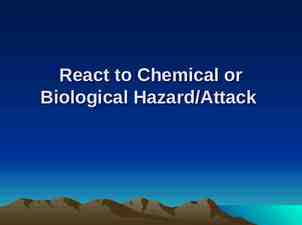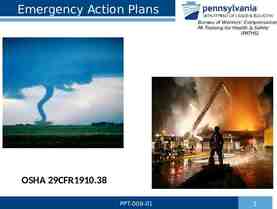Plugging Into the Local Incident Command System Health Physics
52 Slides1.87 MB

Plugging Into the Local Incident Command System Health Physics Society Midyear Meeting February 2005 New Orleans, LA Sponsored with the Assistance of the Health Physics Society Homeland Security Committee

Speakers Tom O’Connell – MA Department of Public Health – Liaison to Hazardous Materials Teams – IAEA Consultant Steve Clendenin – Retired Fire Captain – 26 Years – Deputy Director – MA Hazmat Response – FEMA Urban Search & Rescue Task Force

Agenda The Emergency Environment The Incident Command System Interface Getting Programs Connected

Emergencies – “Sliding the Pole” Two Scenarios – Investigation leading to realization that something BAD is happening. Slow buildup –Rapid Violent Events

Rapid Violent Event Mass Confusion Lack of Information Psychological impact – Death – Injury Need for IMMEDIATE DECISIONS The Buck has stopped with YOU.

Old Bumper Sticker WHEN THE EXPERTS PANICTHEY CALL THE FIRE DEPT.

Emergency Responders are Called When Normal Safeguards Have Failed When Deliberate Harm is Intended – Terrorism – Arson – Revenge / Anger – Loonies

People You Meet at the Scene Victims Responsible Parties – Guilt – Fear of Litigation – Desire to Minimize or Conceal Other Responding Agencies

People You Meet at the Scene People with Good Information People with Bad Information People with “Issues” The Problem is sorting them out

The Scene

I’m an Expert and I’m here to Help you

Sometimes There is No Perfect Answer

Experts Must Understand Their Audiences Needs to be Effective

NIMS / ICS Managing Disaster

Homeland Security Presidential Directive 5 To prevent, prepare for, respond to, and recover from terrorist attacks, major disasters, and other emergencies, the United States Government shall establish a single, comprehensive approach to domestic incident management. The objective of the United States Government is to ensure that all levels of government across the Nation have the capability to work efficiently and effectively together, using a national approach to domestic incident management

What is the National Incident Management System, or NIMS? A system that provides a consistent nationwide approach for incident management Requires Federal, State, tribal, and local governments to work together before, during, and after incidents Involves preparing for, preventing, responding to, and recovering from domestic incidents All causes, sizes, and complexities of incidents

Incident Command System FEMA IS-100 MA Department of Fire Services MA Department of Public Health

Why Use ICS Time Proven System of Management Standardized All Approach Hazards Concept Modular and Flexible Common Terminology

Common ICS Terminology Span of Control Operation Period Facilities – Incident Command Post – Camps – Bases – Staging Areas

Origins of ICS State of California Late 1970s F I R E S C O P E – Firefighting Resources of California Organized for Potential Emergencies Goals – Fire Service Management – Technology – Incident Command – Multi-Agency Coordination

Two Key Concepts Unity of Command – You can only take orders from one person Span of Control – You can only directly supervise a limited number of people

Primary Position Title Support Position Incident Commander Incident Commander Deputy Command Staff Officer Assistant Section Chief Deputy Branch Director Deputy Division/Group Supervisor N/A Strike Team/Task Force Unit Leader N/A Leader Manager Single Resource Use Unit Description N/A

ICS Organizational Titles Standard and Specific to ICS Positions not filled by Rank Qualified Personnel Minimizes Confusion Management Areas

Incident Commander Responsible for Overall Incident – Objectives – Strategies – Priorities Life Safety Incident Stabilization Property Conservation

Command Staff

Command Staff Positions Incident Safety Commander Officer * Liaison Officer Public Officer Information

General Staff Sections Sections Comprise General Staff Chief for Each Management Section

Operations Section Position Title - Operations Chief Executes IAP Operations Responsible for – Reports to IC – Accomplishing Objectives Strategies Tactics Tasks

Planning Section Position Title - Planning Chief Develops the IAP Responsible for – Reports to IC – Data Evaluation – Long Term Direction – Technical Specialists

Incident Action Plan Every Incident - Verbal or Written Provides Direction for: – Operational Period – Measurable Tactical Operations Minimum of Four Elements – What do We Want to do? – Who is Responsible for Job? – How to Communicate? – Procedures for Injuries?

Planning Section Technical Specialists Certain Incidents or Events May Require the use of Technical Specialists who Have Specialized Knowledge and Expertise. Assigned Required. Wherever Their Services are In the Planning Section, Technical Specialists May Report to the Following: – Planning Section Chief – A Designated Unit Leader

Logistics Section Position Title - Logistics Chief Provides Support, Resources Inputs into the IAP Responsible for – Process Requests – Advise on Capabilities – Report to IC

Finance Section Position Title - Finance Chief Provides Support, Resources Inputs into the IAP Responsible for – Process Requests – Advise on Capabilities – Report to IC

Types of Incident Facilities Incident Location Incident Command Post Staging Area Camps Base

Responder Responsibilities Check In Process – Locate Personnel for Emergencies – Ensures Accountability – Organize the Demobilization – Tracking Resources – Prepare for Assignments No Freelancing

Summary of ICS Concepts IC Position Always Filled Command Staff-Officers General Staff – Section Chiefs IAP for Operational Period Common Terminology Used ICS Organization Independent

Summary of ICS Concepts Span of Control 3-7 persons Briefings Must Take Place Only One Base Facility - Fixed Camps Can Move Staging – Waiting Area for Assets ICS - Flexible Management Tool

Questions on FEMA IS-100

Quiz What is RAM? – A. – B. – C. – D. – E. Truck with a Hemi Animal Random Access Memory Radioactive Material Rapid Access Mass Decon YES All of the Above

Do You Understand Me Communication with Common Language is KEY to Success – NO Acronyms – NO Codes Ten Four Big Buddy Understand the Big Picture Quick - to the Point Solutions

Ten Things Not to Say to a FR Sievert Gray Depth Dose Equivalent Let Me Think About That We Can’t Do That You Can’t Do That Committed Dose Effective Dose Be Gentle With The Equipment Discuss the Quantum Theory

Get to Know Your Local Responders Fire Police EMS Lower the Better Offer Training Assistance Get to Know Local/State Assets and Response Organizations

FEMA CERT Program Citizen’s Emergency Response Teams – National Program – Local Implementation Prepares Communities to Respond Training is Local by Local Emergency and Non-Emergency

FEMA CERT Program Benefits – – – – – – Better Understanding of Community Potential Community Hazards Understanding Develops Perspective Improves Disaster Response More Hands Make Lighter Work Credentialing http://training.fema.gov/emiweb/cert/dir.asp

State SERC / Local LEPC U.S. Environmental Protection Agency – Emergency Planning and Community Right-to-Know Act (EPCRA) – Clean Air Act (CAA) SERC – State Emergency Response Commissions LEPC – Local Emergency Planning Committee

Local LEPC Members Local Emergency Planning Committee – Appointed by the SERC – Must Contain Representatives from: Local Officials Local Public Safety Local Public Health Local Emergency Management Local Hospitals Community Groups Facilities Subjected to EPCRA

Local LEPC Activities Develop Emergency Plans – Community Specific – Prepare for And Respond to Chemical – Annual Review of Plan – Exercise the Plan Work with Facilities to Minimize Risk Inform Population of Chemical Risks http://www.rtknet.org/resources.php

Summary Learn the Responder’s View of Incidents Get Integrated into Your Community Understand Your Audience’s Needs – Fast Breaking Events Fast Solutions Understand the Response Systems Learn the Systems Volunteer Your Expertise There is Always a Solution Photo by Capt Cadd CA










